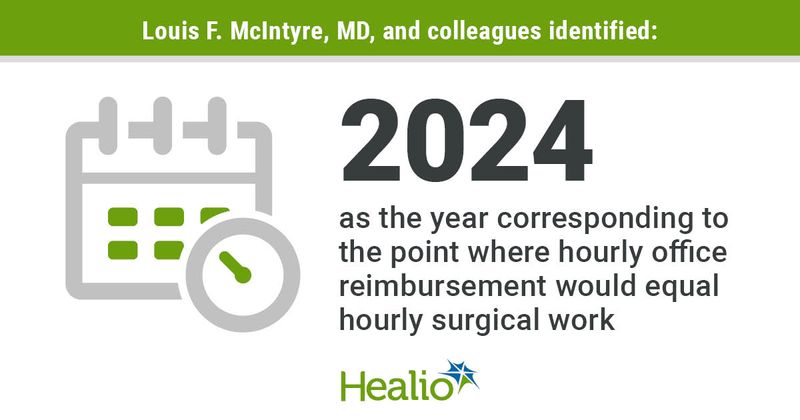Orthopedic surgical reimbursement may equal in-office reimbursement within 5 years
If current reimbursement trends continue, reimbursement for time in the OR performing arthroplasty surgery may be equal to the time spent in the office seeing Medicare patients within the next 5 years, according to published results.
Louis F. McIntyre, MD, and colleagues accessed the Resource-based Relative Value Scale (RBRVS) Update Committee database to extract the time elements for total knee and total hip arthroplasty on the day of surgery.

“The time elements are the same for both [total knee and total hip arthroplasty], and we used just the time elements that are germane for the day of surgery. We cut out all of the postoperative visits that are included in that,” McIntyre, chief quality office for U.S. Orthopaedic Partners, told Healio Orthopedics.

Researchers averaged the evaluation and management (E&M) code mix for two midsized orthopedic practices to create an amalgamated rate for the reimbursement of office work on an hourly rate. Researchers used a graph of the 25-year trend line in Medicare reimbursement for arthroplasty procedures to create a trend line, which was extrapolated to estimate the time in the future that the hourly rate for office work would equal the hourly rate for surgery.
“Traditionally, there has been a premium on being in the operating room as procedure-driven reimbursement has been traditionally higher than E&M or office-based reimbursement,” McIntyre said.
In this analysis, researchers used time inputs and the Medicare conversion factor for 2021. Results showed a total procedural time of 204 minutes for both TKA and THA on the day of surgery. From the average of the two midsized private practices, researchers calculated an amalgamated hourly office rate of 7.9 relative value units for an overall in-office Medicare reimbursement of $318.89 per hour and $1,083.04 for the 3.4 hours allowed in the RBRVS Update Committee database for a joint replacement. When researchers extrapolated the trend line for reimbursement to the $1,083.04 price point, results identified 2024 as the year corresponding to the point when hourly office reimbursement would equal hourly surgical work.
“Both orthopedic surgeons and policymakers in Washington, D.C., as well as the leaders of health systems are going to have to come to grips with the looming parity of surgical and office work reimbursements for orthopedic surgeons because it will affect patient access to care in that, certainly, surgeons may decide to change their care mix and their availability in the operating room based upon their ability to make just as much income in the office as they do in the operating room for Medicare total joint arthroplasty,” McIntyre said.

